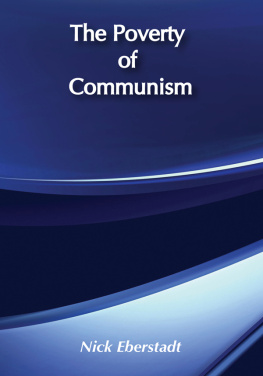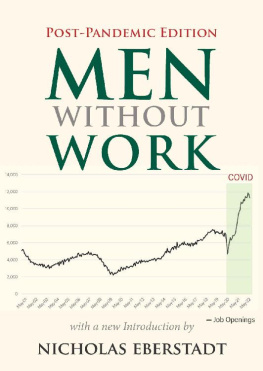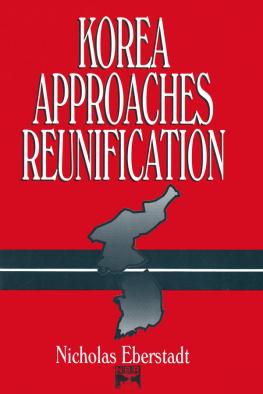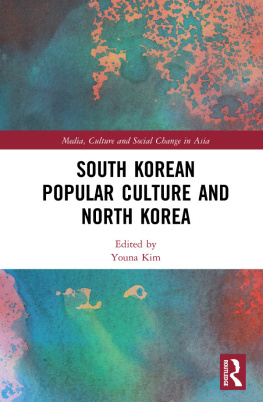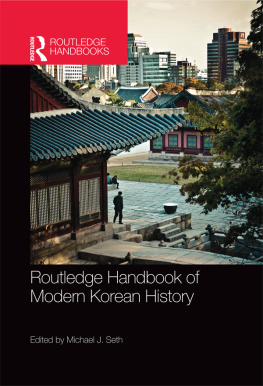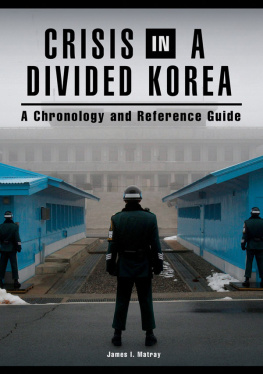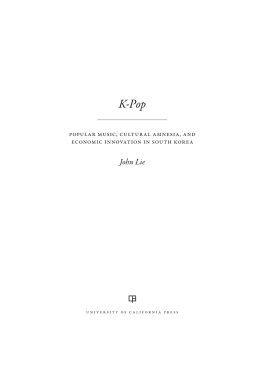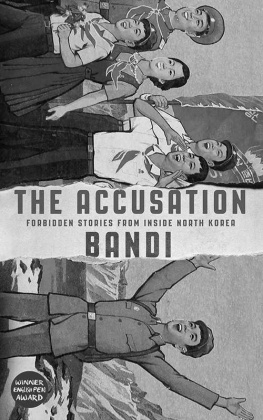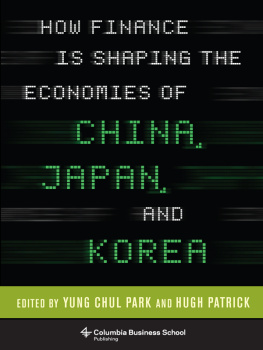Policy and Economic Performance
in Divided Korea during the
Cold War Era: 194591
Policy and Economic Performance
in Divided Korea during the
Cold War Era: 194591
Nicholas Eberstadt

Distributed to the Trade by National Book Network, 15200 NBN Way, Blue Ridge Summit, PA 17214. To order call toll free 1-800-462-6420 or 1-717-794-3800. For all other inquiries please contact the AEI Press, 1150 Seventeenth Street, N.W., Washington, D.C. 20036 or call 1-800-862-5801.
Library of Congress Cataloging-in-Publication Data
Eberstadt, Nick, 1955
Policy and economic performance in divided Korea during the Cold War era : 1945-91 / Nicholas Eberstadt.
p. cm.
Includes bibliographical references.
ISBN-13: 978-0-8447-4274-8
ISBN-10: 0-8447-4274-0
1. Korea (South)Economic conditions1948-1960. 2. Korea (South)Economic conditions19601988. 3. Korea (South)Economic conditions1988 4. Korea (North)Economic conditions. I. Title.
HC467.9.E34 2008
330.9519'04dc22
200804047712
2010 by the American Enterprise Institute for Public Policy Research, Washington, D.C. All rights reserved. No part of this publication may be used or reproduced in any manner whatsoever without permission in writing from the American Enterprise Institute except in the case of brief quotations embodied in news articles, critical articles, or reviews. The views expressed in the publications of the American Enterprise Institute are those of the authors and do not necessarily reflect the views of the staff, advisory panels, officers, or trustees of AEI.
Printed in the United States of America
Contents
Tables
Acknowledgment
The author would like to express his special thanks and appreciation to the Korea Foundation for the generous support it has granted toward the publication of this book.
Introduction: The Experiment
On its face, Korea during the Cold War would seem to offer the student of political economy virtually unparalleled opportunities for examining the relationship between polity and material development. In its fundamentals, in fact, the outlines of modern Korean history sound almost as if they had been specified by a meticulous (if chillingly callous) social scientist who had carefully devised a research experiment involving tens of millions of human beings.
Consider the initial conditions:
After many centuries of rather isolated and perhaps somewhat uneventful self-rule, (heretofore, a notion utterly alien to the peninsula).
After three or four decades of externally enforced social and economic transformation, the populace is liberated from its colonizing power, but divided in two by an almost utterly arbitrary boundary line drawn by the liberators. Though regional characteristics and other distinctions would doubtless be evident to a population long isolated from others and sensitive to indigenous differences, the newly divided population may fairly be described as ethnically homogeneous and, in any event, views itself as a single group with a single language, culture, and heritage.
After brief experiences under their respective trusteeships, the newly independent states are soon locked together in a costly and devastating war; by virtue of its wide path of destruction, the war seems to level those regional economic differences that had arisen under colonial occupation.
Following their ceasefire, the hostile states have virtually no contact with one another. Instead, they embark on their own, avowedly opposite, paths to reconstruction and development.
Even in its particulars, the circumstances of Koreas unhappy partition might look fortuitous to the student of political economy. The division of Korea under the peninsulas two current states has continued for many decadessurely long enough, from the standpoint of experimental design, for divergent polities to evince characteristic social and economic results. The sudden, unexpected, and almost complete separation of the population into two large segments (with the smaller one in the north accounting for as much as one-third of the overall total) limited opportunities for self-selection between the groups, which were divided from each other in as random a fashion as forces of history might seem likely to allow.
By the end of the Soviet era in late 1991, the results of the experiment had been more or less conclusively established. The economy of the Democratic Peoples Republic of Korea (DPRK) was mired in stagnation, its citizens exposed to increasing privation; within a few years, North Korea would suffer a catastrophic food shortagethe first and only mass famine ever to befall a literate and urbanized society during peacetime. The Republic of Korea (ROK), by contrast, was enjoying rapid (if erratic)
Looking backward from our current vantage pointfrom the era after the Soviet collapseit might seem tempting to suggest that the results of this experiment were foreordained, that Soviet-style economies are doomed to failure in competition against their market-oriented alternatives. But as we shall see in the following pages, the outcome of this experiment was hardly predetermined. The economic race between North and South Korea between partition in 1945 and the end of Soviet Communism in 1991 was just that: a real race. For much of that period, moreover, it was the DPRK, not the ROK, which seemed to be in the lead in that race. This study is an examination of that raceand of the factors that eventually, somewhat haphazardly, but nonetheless fortuitously, led to the outcome we now take for granted.
Limits of Observation
By the forensics already noted, the modern Korean experience would appear to be framed as much like a gigantic hypothesis-testing experiment as any student of development might care to hope. Unfortunately, there is a catch.
Returns from this experiment were accumulating since at least 1948, when the Republic of Korea, with the blessing of the United States, established its sovereignty over the southern portion of the peninsula, and the Democratic Peoples Republic of Korea in the north took formal power over the territory the USSR had been helping to Sovietize. But the results are anything but simple to compare. Throughout the Cold War, both states on the Korean peninsula were loath to release the sorts of information that would permit a comprehensive and impartial assessment of their social and economic performance during this period.
That reluctance is easy to explain. Simply put, the governments of both North and South Korea asserted that the superiority of their respective orders would be demonstrated by their economic and material records. Under Koreas circumstances at that timewith as many as two million soldiers facing each other across a cease-fire line, commanded by governments each claiming sole authority to reunite the peninsulas populacelegitimacy was more than an abstract consideration. Precisely because both governments regarded the comparison of their records as so vitally important, they both, in varying degrees, went out of their way to obscure the assessment for independent or disinterested parties.
In our post-Soviet era of globalization, students of all the social sciences have come to take for granted the availability of reliable quantitative data from practically every corner of the world. For inquiries about development economics, comparative development, political economy, and even, surprisingly, economic history, massive amounts of data are often at the ready. One can choose to work with a remarkably diverse array of national and international micro- and macro-data files; with historical data sets; with survey data; with panel data; and more. Indeed, the very plenty of such quantitative information has shaped the research approach in all these areas over the past two decades. Much of the great work in these realmscontributions in both extending the boundaries of knowledge and refining or improving statistical research techniqueshave been predicated on the surety that a scholar can function fruitfully nowadays as a data consumer. The present study is very much out of keeping with that tendency in modern scholarship, howeverfor, in our particular investigation, the data are not given. Before we can offer an evaluation of the developmental race in the Korean peninsula during the Cold War era, we must first establish the facts of the caseand establishing those facts, even today, is no easy thing.


